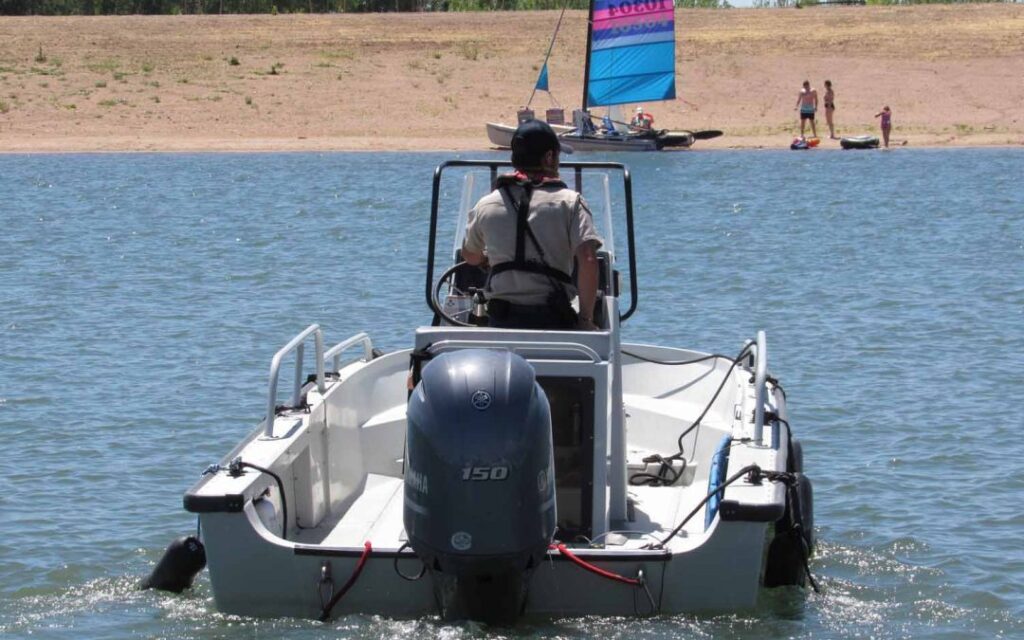
By Jerd Smith
Chatfield Reservoir, one of the largest liquid playgrounds in the Denver metro area, will take on a new role this year, storing water under an innovative $171 million deal completed last month between the state, water providers, environmental groups and the federal government.
For millions of boaters, campers, cyclists, runners and bird watchers, the 350,000 acre-foot reservoir that sits southwest of the city is a year-round recreational hot spot, with 1.6 million annual visitors.
But for thirsty Front Range communities and farmers nearby and downstream, including Highlands Ranch, Castle Rock, the Greeley-based Central Colorado Water Conservancy District and six other water providers, Chatfield represents a rare opportunity to transform a reservoir once designed strictly for flood protection into a much-needed water storage vessel, a key goal of the Colorado Water Plan.
Thanks to the redesign, the reservoir will be able to hold an additional 20,600 acre-feet of water, an amount sufficient to serve more than 40,000 new homes or irrigate roughly 10,000 acres of farm land, while maintaining its ability to protect the metro area from flooding, according to the U.S. Army Corps of Engineers.
“It is cool to see it done,” said Randy Ray, manager of the Central Colorado Water Conservancy District and president of the Chatfield Reservoir Mitigation Company, Inc., which oversees the project. “It will be better when it fills up with water.”
Originally built by the Army Corps in 1975 to help control the South Platte River during floods, by the 1990s water agencies and others began looking at ways to actually store water there.
It wasn’t easy. To raise the shore level, hundreds of acres of land along the reservoir’s banks were revegetated to replace low-lying areas that will be inundated as water is stored. The cove that houses the marina was dredged, new boat ramps were built, and new habitat for birds was created downstream in Douglas County.
A 2,100 acre-foot pool of water for environmental purposes was also set aside. It will be used to provide water for recreation and improve flows for the South Platte River through Denver, Ray said.
Though the project has been praised for its multi-purpose nature, it also triggered a long-running battle with the Denver chapter of the Audubon Society, which feared the construction damage to bird habitat would not be adequately repaired in the reservoir’s new design.
The society’s lawsuit to stop the project ultimately failed. But Polly Reetz, the chapter’s conservation chair, said they plan to closely monitor how habitat and birds respond.
“We’re still not convinced it’s going to work,” Reetz said. “They’ve done some good work out there. Plum Creek is much better. But we plan to watch it very carefully and see what happens.”
The project’s $171 million price tag was paid by the cities and farmers who will store water there, with additional funds provided by the Colorado Water Conservation Board and the federal government.
“This project is a great example of federal, state and local authorities working together to address vital water supply issues along the Front Range,” said Army Corps Omaha District Commander Col. John Hudson in a statement.
That the reservoir is a highly valued part of the outdoor recreation scene in metro Denver was clear Monday morning. More than two dozen cars waited patiently to enter the park, campgrounds were brimming with visitors, and paddle boaters and sailors were already gliding across the lake.
Elizabeth Jorde and her son Jeremiah were waiting at the marina, hoping to reserve a slip for their family pontoon boat on Father’s Day.
Jorde said she’s looking forward to seeing what a fuller reservoir will look like on the many days she and her family come out to relax. But she also said the $171 million price tag seemed steep for the amount of water the project will store.
“I was flabbergasted,” she said. “It will be interesting to see if it is worth it.”
For Randy Ray the project will provided 4,274 acre-feet of critical new storage space for the farmers in his district, who anteed up $20 million to help get the deal done.
And he said it is proof that collaborative solutions to Colorado’s looming water shortages can be found.
“We rolled up our sleeves, put our differences aside and got this thing built,” Ray said.
Jerd Smith is editor of Fresh Water News. She can be reached at 720-398-6474, via email at jerd@wateredco.org or @jerd_smith.
Fresh Water News is an independent, nonpartisan news initiative of Water Education Colorado. WEco is funded by multiple donors. Our editorial policy and donor list can be viewed at wateredco.org
This story originally appeared on Fresh Water News on June 10, 2020.
The Water Desk’s mission is to increase the volume, depth and power of journalism connected to Western water issues. We’re an initiative of the Center for Environmental Journalism at the University of Colorado Boulder. The Water Desk launched in April 2019 with support from the Walton Family Foundation. We maintain a strict editorial firewall between our funders and our journalism. The Water Desk is seeking additional funding to build and sustain the initiative. Click here to donate.





